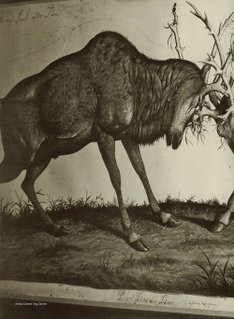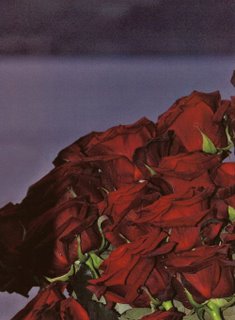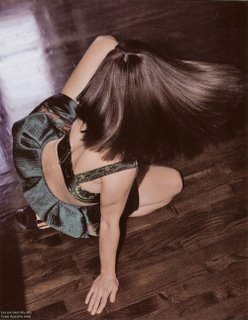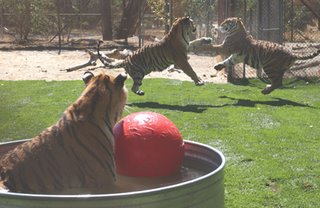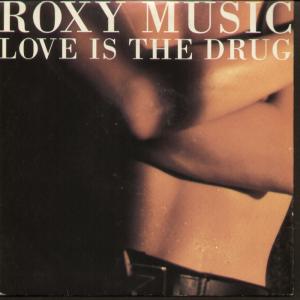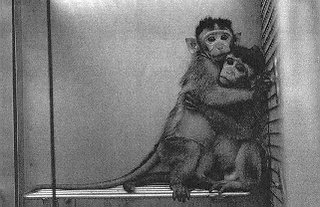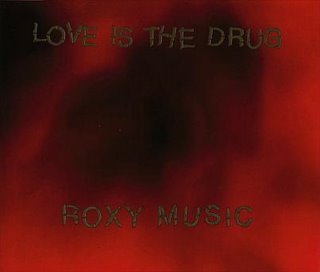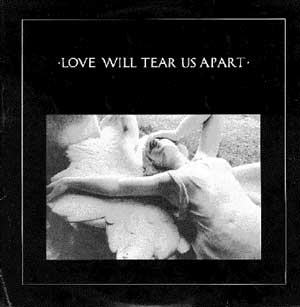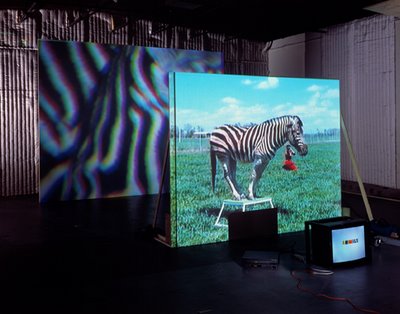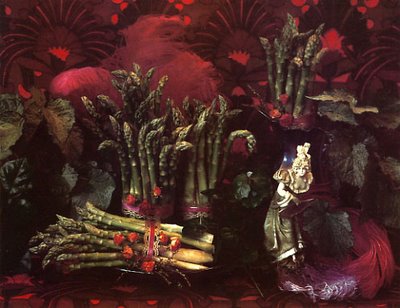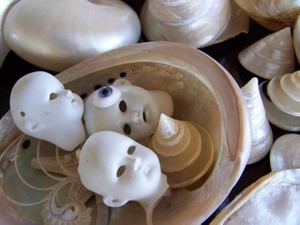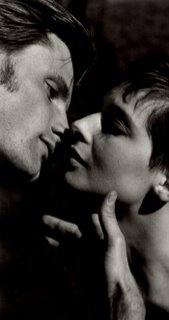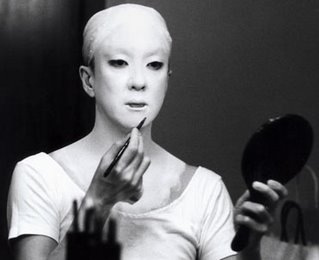
The December/January issue of French Vogue, of which she is editor in chief, had started landing on the doormats of its subscribers when we met in December at Vogue's HQ on rue du Faubourg Saint-Honore in Paris, and the angry phone calls were coming thick and fast. Her assistant answered another three before I'd even taken my seat in Roitfeld's office. The issue had a special guest editor - John Galliano - and came with a calendar for 2007 featuring 13 images of pre-Raphaelite beauty Karen Elson, one of Galliano's favourite models, in skimpy black clothes and tied up with curtain cord. 'Glamour bondage', as Roitfeld put it; nothing more shocking than you'd find in the window of your local Ann Summers, although, obviously, infinitely more stylish. But some of the subscribers 'are furious', she reports. Her slightly frazzled laugh isn't enough to hide the fact that she's annoyed, maybe because she's particularly proud of the images of Elson - which she styled herself.
'I think is beautiful and a bit osé [daring]. Is like a modern Pirelli calendar, non? We try to push. But my assistant is like this with the phone [she holds an invisible receiver at arm's length as if being screamed at] for three days now, listening to insults from feminists. In France, you have Paris, and you have the rest of the country,' Roitfeld says. 'I think the rest of the country don't like us, and we don't know them ... Those who don't like the calendar are not from Paris, they are mostly from the other part of France.' Significantly, she refers to her magazine not as French Vogue, but Vogue Paris. And heaven help Disgusted of Tupin-et-Semons when she finds the picture of John Galliano stark naked in the magazine itself.It's not the first time that Roitfeld's desire 'to push' has shocked sensitive souls. The unconventional way she uses humour to puncture fashion's pretentious tendencies, and sexuality to shake up its conservatism, has on occasion rubbed both her readers and her peers up the wrong way. Her styling in Tom Ford's Nineties reinvention of Gucci quickly picked up the label 'porno chic' for its slinky, sexy, Studio 54-era look. Even a decade ago, shoots with long-time collaborator Mario Testino for style magazine
 The Face aroused similar controversy. A hilarious shoot featuring a Princess Anne lookalike in a T-shirt bearing a scored-out 'Diana' sparked letters of complaint about lack of respect for the monarchy and insensitivity (the story appeared just before Princess Diana's death, which was hardly Roitfeld's fault). Another, which cast supermodel Eva Herzigova as a maniacal butcher in a blood-spattered apron playing with pieces of raw meat, also drew flak, particularly the image of her caressing the blade of her meat cleaver.
The Face aroused similar controversy. A hilarious shoot featuring a Princess Anne lookalike in a T-shirt bearing a scored-out 'Diana' sparked letters of complaint about lack of respect for the monarchy and insensitivity (the story appeared just before Princess Diana's death, which was hardly Roitfeld's fault). Another, which cast supermodel Eva Herzigova as a maniacal butcher in a blood-spattered apron playing with pieces of raw meat, also drew flak, particularly the image of her caressing the blade of her meat cleaver.Of course, such disregard for fashion's forces of conservatism is what makes Roitfeld's work so exciting. Her arrival at French Vogue in 2001 brought a youthful energy to an ageing institution which, she readily admits, 'hadn't been so good' since the mid-Eighties. At that time, Paris was undergoing a wholehearted rejuvenation, with a generation of designers barely into their thirties being appointed as head designers of its most famous fashion houses: Nicolas Ghesquiere at Balenciaga, Hedi Slimane at Dior Homme, Phoebe Philo at Chloe. Roitfeld's appointment at Vogue seemed to anoint the arrival of this new generation. And while her youthful irreverence may have ruffled a few fusty feathers, it has revived the magazine's fortunes: in 2005, advertising revenue leapt 60 per cent, making it the best year for ad sales in two decades. 'I make big errors,' she says modestly, 'and I may be a bit punk sometimes, but I try to make it exciting for the reader. And the readership figure goes up. It will never be 'uge - because if it is 'uge it will be a different sort of magazine, too popular. So I cannot be too big. But we keep going up bit by bit ... the boss is happy.'
The boss must be happy. It was announced last autumn that Roitfeld would be taking over as editorial director of the biannual men's fashion magazine Vogue Hommes International. With her first issue due in March, anticipation as to quite how Roitfeld will reinvigorate the menswear title is growing. She's the first to acknowledge that working on the magazine will not be easy. Its reputation and influence have waned in recent years (that ageing rocker Lenny Kravitz was a recent cover star says it all).
 'You know, there are a lot of good men's magazines. In England you have Arena Homme+ and Another Man; and in France we have L'Officiel Hommes. But all are looking similar.' In contrast, Vogue Hommes International will be 'more journalistic. OK, there will be a lot of fashion; but a lot of big articles, too. I think it's difficult to do fashion for men, because either you become very over-homosexual fashion or very boring fashion. You don't want a boy who looks 15 in a little pair of shorts with some strange art ... But to see just a jacket and tie is boring.'
'You know, there are a lot of good men's magazines. In England you have Arena Homme+ and Another Man; and in France we have L'Officiel Hommes. But all are looking similar.' In contrast, Vogue Hommes International will be 'more journalistic. OK, there will be a lot of fashion; but a lot of big articles, too. I think it's difficult to do fashion for men, because either you become very over-homosexual fashion or very boring fashion. You don't want a boy who looks 15 in a little pair of shorts with some strange art ... But to see just a jacket and tie is boring.' Also, she points out, she has made sure that '80 per cent' of the stylists on Vogue Hommes are women, because they are better qualified to know what makes a man look attractive. Most crucial of all, she reckons, is the selection of the male faces that will appear in its pages. 'Because men's clothes are less fun, less interesting than women's clothes, non? So I like to use some people who are not models, who are not 16.' Her cover star is being shot a few days after I meet her ('I cannot say the name because I am very superstitious') and the photographer is her old friend Mario Testino: 'He is my good luck.'
Also, she points out, she has made sure that '80 per cent' of the stylists on Vogue Hommes are women, because they are better qualified to know what makes a man look attractive. Most crucial of all, she reckons, is the selection of the male faces that will appear in its pages. 'Because men's clothes are less fun, less interesting than women's clothes, non? So I like to use some people who are not models, who are not 16.' Her cover star is being shot a few days after I meet her ('I cannot say the name because I am very superstitious') and the photographer is her old friend Mario Testino: 'He is my good luck.'Roitfeld and Testino, possibly the most famous fashion photographer in the world, have been working together since the mid-Eighties. Roitfeld claims she had a tendency to be negative before she met him, blaming her 'half-Russian blood'. (Her father was the Russian film producer Jacques Roitfeld - 'I think my craziness and glamour come from him. The Russians are very much more up and down than the French,' she says.) 'Mario gave me positivity because he is South American, so he is full of energy. He pushed me all the time. I don't think I'm any better [as a stylist] than 15 years ago; it is Mario makes me more international, more visible.' Certainly visible enough to catch the attention of designer Tom Ford in the mid-Nineties, when he was trying to revive Gucci's reputation. When Ford first approached Roitfeld and Testino to work with him, they refused. 'But he called, he called, he called. And one day he come to visit us on a shoot and we said, "Oh, he is very good-looking ... Let's do the job with him!"'
Jonathan Newhouse, chairman of Vogue's publisher, Conde Nast International, was similarly keen to offer her the French Vogue job in 2001. This was a completely new departure for Roitfeld, who had been freelance her entire life - first as a writer for French Elle, before turning her hand to styling. 'I never had an office before, never had a chair with a table ... Have never been a boss.' Even now, she's still a stylist, shooting several stories a month for Vogue Paris. 'Daytimes I am editor in chief; after eight and at weekends I am a stylist. It is great! There is no one to criticise my work other than me.'
On the wall of her office hangs a black-and-white portrait of Roitfeld by her friend Karl Lagerfeld. It's iconic Carine: hair swept forward to obscure half her face, her one visible eye framed with smudged eyeliner and topped with a slab of eyebrow. A white thread runs vertically down the left-hand side, suggesting it might be a still from a Super-8 film, in the style of Andy Warhol's Screen Tests. But this imperfection is too perfect: look closer and there are other 'imperfections' - the blocky disruption of pixelation gives the image away as a product of digital technology.
'Very Big Brother, no?' says Roitfeld, noticing me look at it. I'm sure she's referring to Nineteen Eighty-Four, rather than reality TV. 'The cult of personality ... very Russian.' The cult of personality is something Roitfeld knows all about: her five years at French Vogue have seen her influence extend well beyond fashion's inner sanctum. Reflections of her 'smoky-eyes' image have rippled out from catwalks to magazines to shop-window dummies. Never mind that Women's Wear Daily crowned her 'the muse of the moment' or that Vanity Fair listed her as one of the world's best-dressed women; the Sunday Times Style section and ES magazine have devoted pages to anatomising the Roitfeld look. It would be easy to mock the way women's magazines have fussed over her youthful looks, slim figure and rejection of botox, but it has to be said, meeting her face to face, it's hard to believe she's 51, the mother of two grown-up children. She's been lucky, she says, the way her life has panned out. Christian Restoin, her partner of almost 30 years (she prefers the word 'husband' although they're still not married, she says, because 'like most Russians I am very superstitious, and if I don't get married, I don't get divorced'), was the founder and owner of a successful shirt company, giving her 'the luxe of not having to work too much'. One benefit has been the freedom to pick and choose work. 'If you struggle to pay bills, working on advertising you don't like, on magazines you don't like, at the end of the day is difficult to still like fashion. You know, is like when you squeeze a lemon ... whereas I still have some juice.'
 Another advantage was that she could focus on bringing up her children, while she watched overworked colleagues guiltily juggling motherhood and career-maintenance. 'I only start to work really hard when they grow up. Now I work every day, Saturday, Sunday - but the children are big, they study far away.'
Another advantage was that she could focus on bringing up her children, while she watched overworked colleagues guiltily juggling motherhood and career-maintenance. 'I only start to work really hard when they grow up. Now I work every day, Saturday, Sunday - but the children are big, they study far away.'When Tom Ford launched his first scent, Black Orchid, last November, Roitfeld's daughter Julia was chosen to be the star of its advertising campaign. Carine opens an issue of French Vogue and there on the first spread is Julia Roitfeld Restoin, a picture of golden-era Hollywood glamour, holding a bottle of Tom Ford Black Orchid. 'Is strange that Tom decide to choose Julia ...' She frowns sulkily. 'Why not me? Ha ha, I am joking! He didn't want someone well known; he want a new face. Is great, non?' As she looks at the image, for the briefest moment her demeanour of cool fashion editor makes way for a more common expression: that of a mum at a school nativity play. You must be proud, I say, and her usual composure snaps straight back into place. 'Of course you are proud,' she shrugs, 'because is a beautiful picture. But is good for her because it give her some confidence by being chosen. Because maybe is difficult to be my daughter. Because I'm still very photographed, I make my own business, I'm quite successful.'
Julia lives in New York and works for Baron & Baron (an advertising and design company), as well as her own design agency, Global Design Inc: 'She just starting with that and she do some little jobs, like the Christmas card for [fashion designer] Zac Posen, so I am very happy.' Roitfeld's son, Vladimir, was also briefly a model, but these days he prefers student life in the United States. 'It was my friend Hedi Slimane who made him a model when he was 16, but Vladimir did not like it at all.' His brief spell in that world opened his mother's eyes to the less attractive side of the profession, and may even have influenced her decision to use older models in Vogue Hommes International. 'I met some of these guys, they very young, they come from the old part of the world - Argentina, Sweden, east Russia - they don't know anything, they don't know the language and they are not very well treated. Vladi would bring these poor guys home for spaghetti because often they have no money at all, they even don't eat. Is a harder business for boys than for girls, I think.'
Wasn't she once a model herself, I ask. She demurs. 'I was in London and I do a cover for [Eighties fashion mag] Look Now. I was not,' she says, with comic understatement, 'a big top model.' I remind her that she modelled for Kenzo, too. 'Yes, Kenzo loved me, made all the clothes on me.' She laughs. 'It make me very old to say that. Make me an antiquity.'
Roitfeld has been in charge of French Vogue for more than five years now. It was never her ambition to be here, she says; she's never had anything as organised as a career plan. 'I don't think I will do this for my entire life, though. Because I love a challenge.' So where next? She might return to writing, she offers, to write a movie script about fashion, because no film has managed to portray the industry realistically. She saw The Devil Wears Prada, although not entirely of her own volition. 'I don't go to the cinema often, I don't have the time. But I saw it on the plane. I think Meryl Streep is amazing, but I don't think it's the reality of fashion.'
On the subject of ambition, I venture, in The Devil Wears Prada the editor of French Runway (for Runway read Vogue) has her eye on the editor's role at American Runway ... Is that a job Roitfeld would want?
'The ultimate Vogue to do would be the American Vogue, because it's 'uge ...' She sounds almost tempted, before saying, repeatedly, what a great job she thinks Anna Wintour is doing. Roitfeld knows first hand: she worked at US Vogue as a stylist in the late-Nineties. She considers the idea again before making her mind up. 'I have more fun doing my magazine. We French, we small! We can smoke on the cover, we can show tits, we can do crazy calendar; we have a lot of freedom that they don't have in America. I think I would be very frustrated not to be able to do all my craziness that I'm able to do here in France.'
by Murray Healy





























